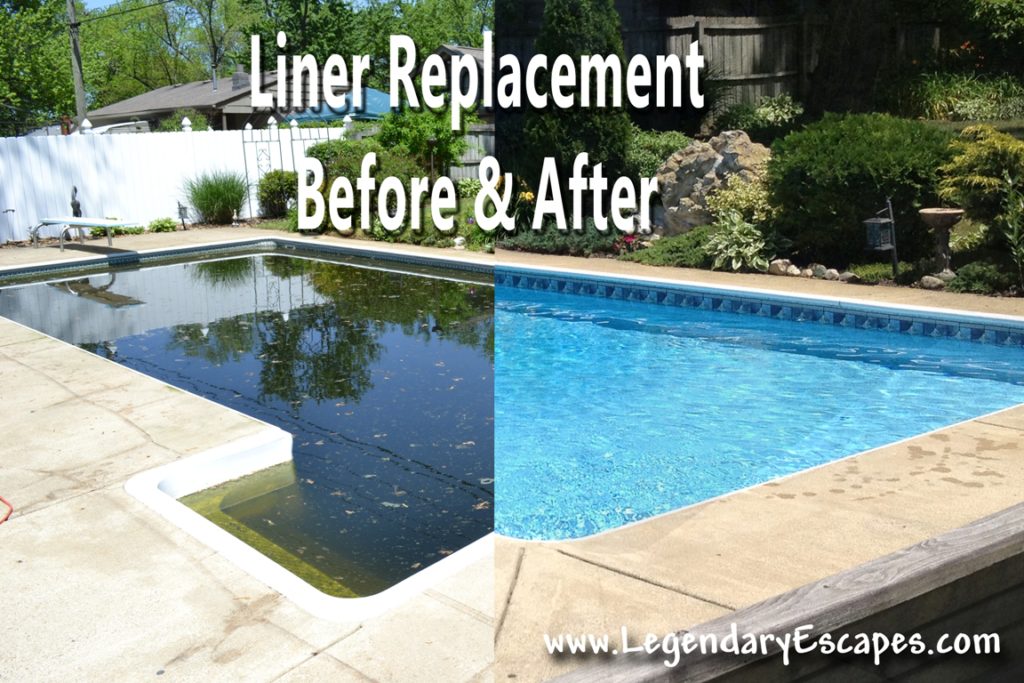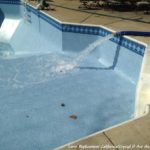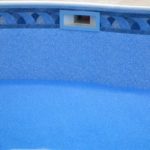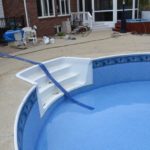
 You may have heard liners referred to in thickness, mil or gauge. What do these terms mean, and how does it relate to your swimming pool?
You may have heard liners referred to in thickness, mil or gauge. What do these terms mean, and how does it relate to your swimming pool?
Mil vs. Gauge
A “mil” is a unit of measurement used to describe a measurement to one thousandth of an inch. It is not related to millimeter in this case.
A “gauge” measurement is approx. 10% less than a mill.
A 35 gauge liner would be roughly the same thickness as a 30 mil liner. For comparison (thanks to our friend Will over at Kafko), a sheet of paper is about 10 mil, a credit card 30 mil and a dime 50 mil (all numbers are approximate).
Latham/Kafko refers to their liners in terms of mil.
How thick should a liner be?
The thickness a liner should be really depends on your particular pool. Here are some things to consider:
- Thicker liners will cost a bit more than their thinner friends.
- Something sharp will puncture a liner, whether it is 20 mil or 27 mil.
- Thinner liners stretch more easily and will custom form more easily to in pool seats, benches, and twists and turns.
- The thicker a liner is, the more difficult the installation will be to ensure a proper fit, and the heavier the liner will be to transport.
- The sun and chemicals will fade your liner equally, whether it is thick or thin.
- All liners offered by Kafko/Latham are quality liners, and all liners installed by the Ask the Pool Guy team are installed with experience, so choose the pattern you like over the thickness when making your decision, unless you have a specific reason to need one vs. the other.
- With the DuoMax or SuperMax options from Kafko/Latham, you’ll get the combination of thicknesses in your pool. This may be nice if you want more support or thickness on the liner walls, with the ease of installation on the floor for a great fit, hence the 27/20 blend (walls are 27/floors are 20).
So Many Patterns, How do I choose?
When looking at liner patterns there can be pressure to choose correctly! Here’s the secret, there’s really no wrong answer! All liners have their place, and if you go with your intuition, you’ll always be correct! After all, you may only choose one liner every twenty years – (give or take depending on use and care), so you’ll likely live with it for a while. After a while the patterns may begin to blur together, and the pressure to choose just the right one can be hard to narrow down. Here are a few tips to use when choosing your liner.
-
Colors
- Water Color Spectrum – The water color in your pool will vary based on the color intensity of the liner you choose. Hint: It’s not the actual liner that makes your water turn it’s various shades of blue, it’s the light hitting the liner through the water and absorbing or reflecting colors in the spectrum. This is also why your liner will look different on a cloudy day vs. a sunny day, and when the sun is in various positions overhead!
- Light– the lightest colored liners, from white to light blues, will give you the “brightest” pool no matter what the sunlight. You may also see dirt and debris more easily, and the seams of a pattern printed on a white back will show white lines, while the liners printed on a blue back will show blue lines.
- Medium – the medium print liners will either be printed on a white back or a blue back. Keep this in mind when choosing – you’ll see minimal seams with the technology available in the UltraSeam liner making process, but you may still notice them. The medium blues will give you a variety of shades from light medium to dark medium blues depending on the daylight and your outdoor conditions.
- Dark – dark liners have become more popular in recent years. In the dark grey granite tones they are thought to mimic the look of gunite or pebble pools, which is why may people are choosing them. Some people choose a dark liner because they want the sunlight to be attracted and absorbed by the liner (which does happen, but the measurable amount is likely hard to detect.) A dark liner will show chemical “burns” more easily than a white liner, though this will only happen when chemicals are used incorrectly. We do see people dumping granular cal-hypo shock into pools, or granular pH minus, if either of these chemicals or many others are left to settle on liners, that is when your bleaching will occur. Some dark liners are printed on white backgrounds, others on black, grey or blue. Keep this in mind. In the dark/white combination, you will definitely see the seams running across the pool. This isn’t an issue – some people like them – some people don’t, so it comes down to personal preference.
-
Patterns
- Tile Patterns – Floor or Wall Patterns – When choosing a liner often people ask if they can combine one tile pattern with another bottom pattern. The answer to this is no, and sometimes yes. The individual liner manufacturers don’t have the technology at a budget friendly price to be able to customize liners to that degree. This is why the liner “sample” books often have a variety of bottom (wall/floor) patterns mixed and matched with a variety of tile patterns. The combinations are selected by designers in the industry based on trends in home decor, color selection, and what will work well together. A handful of end liner fabricators have the machines to be able to mix/match patterns and tiles. You’ll likely be paying a nice upcharge for something like this, additional lead time on liners (and we imagine the waste factor goes up as well with the use.) Perhaps some day we’ll have print on demand liner technology where you can create a liner image on the graphic design program and hit enter to print. We’re just not there yet.
- Tile Patterns – The tile pattern on a vinyl liner serves a purpose. It’s purely cosmetic. With filling and lowering pool water levels, top off’s and evaporation, your water level in the pool will fluctuate. combine that with nature, swimmers/bathers, and suntan lotions, potions, and oils, and you have a combination ready to leave a delightful scum line, or ring around the (bathtub) like stain on your pool. (Hint: Gunite Pool Tile serves the exact same purpose!) The goal of the tile is to accent your pool, and to disguise and hide this delightful scum line so it’s not noticeable, and so it will blend in until you can clean it properly. (Bonus hint: Cleaning a tile pattern in a pool can be as simple as raising the water level and letting your chemicals do the work, wiping it down with a tile/vinyl cleaner, or using a Mr. Clean Magic Eraser* to give it a little scrub *as always test before use.)
- Floor Patterns – The floor color or pattern of your liner will help to give your swimming pool a look all it’s own. The color of your pool will vary throughout the day (and night). The patterns are meant to give you a visual aesthetic. Keep in mind, darker liners will hide more dirt/debris, medium a little less, and white/light not very well at all. Some people with a pool cleaner will not mind a white liner at all – others will appreciate it pointing out where the cleaning needs to happen. Choose your liner based on what you’d like to look at – possibly for the next twenty years…or three. It’s all up to you!
Enjoy your swimming pool – and choosing your liner. If you’re on the fence about replacing your liner – take the plunge. A new liner can breathe new life into a swimming pool and into an outdated back yard. It’s a way to refresh and renew your space, and it really doesn’t cost much to do.
Happy Swimming!









